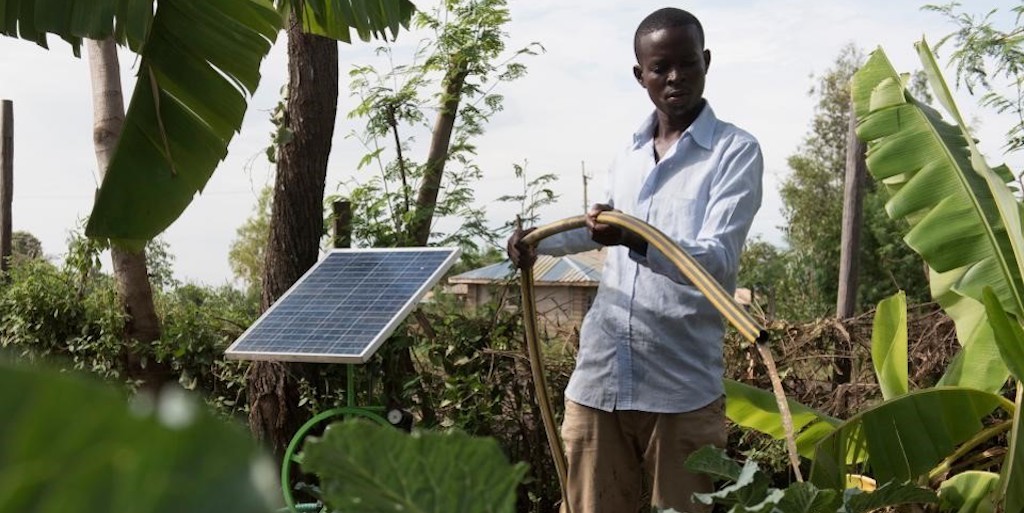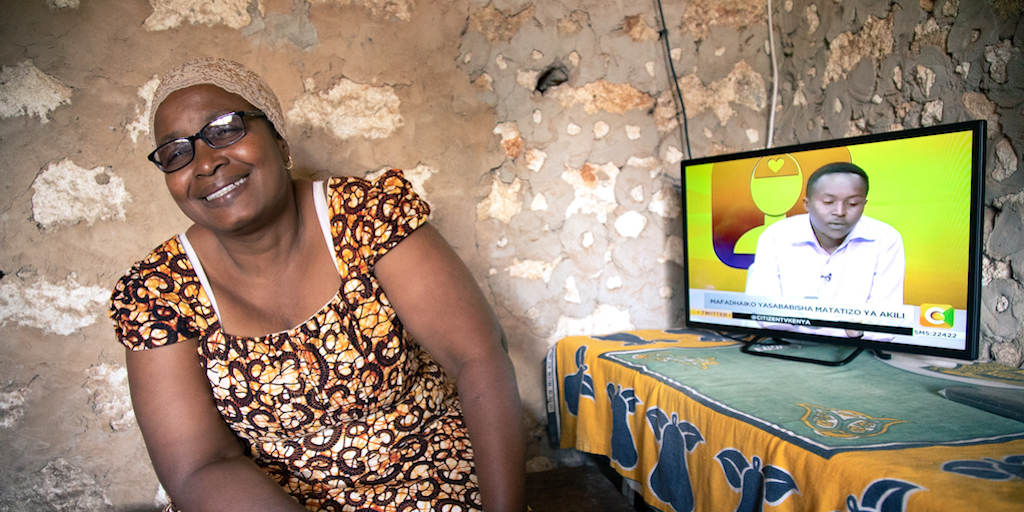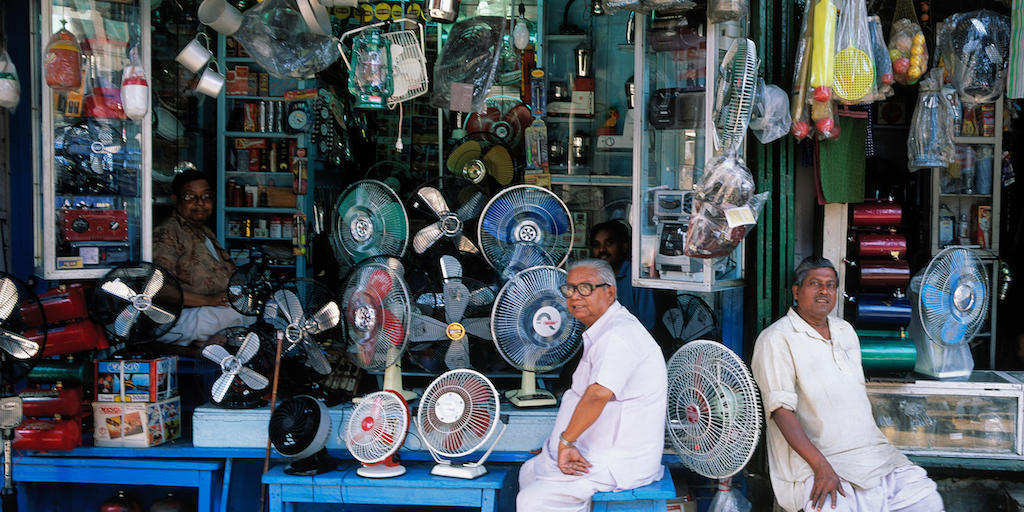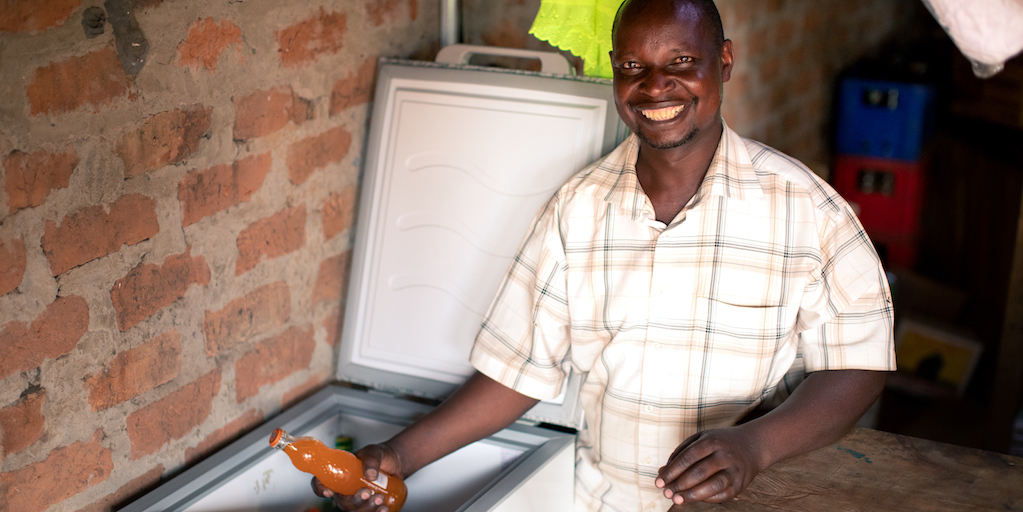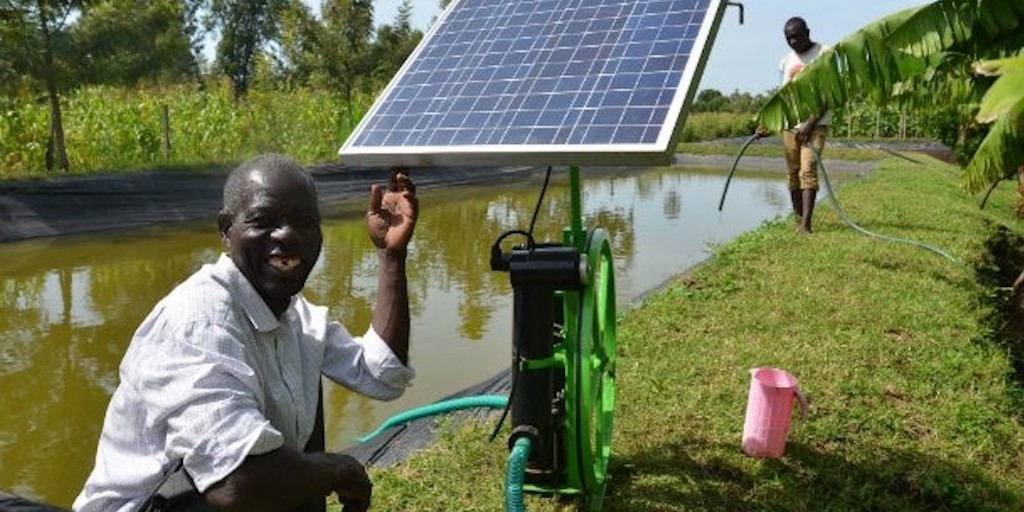Supporting Circular Economy for Renewable Energy Projects

The demand for more renewable energy technologies such as solar panels and wind turbines is creating pressure on the environment due to mining of critical metals and production of more e-waste as these technologies reach their end-of-life cycle, creating an opportunity for a circular economy. In a circular economy, materials have multiple life cycles and re-entry points into the market as they are systematically recovered, repaired and remade.
CLASP is part of a team that supports the U.S. Agency for International Development’s (USAID) Scaling Up Renewable Energy (SURE) program. CLASP was recently awarded a subcontract under the SURE program, led by Tetra Tech, alongside dss+ to engage strategically with governments, the private sector, civil society, and communities to support transformational policies and initiatives and to build human capital and institutional capacity to address waste challenges associated with renewable energy investments while creating economic value and jobs. Tetra Tech, CLASP, and dss+ technical experts work with partners to develop innovative tools, sustainable practices, policies, business models, and secondary markets for renewable energy parts and materials, cultivating a circular economy that is gender-inclusive, reduces waste, makes the supply chain more resilient, and extends the life of parts. CLASP supports USAID in the development of country-specific circular economy plans to ensure the demand for renewable energy sources does not negatively impact the environment.
Renewable Energy: Sustainable Solution or Environmental Risk?
Obsolete renewable energy equipment is expected to grow exponentially over the next 30 years. Instead of damaged and decommissioned equipment piling up as waste, the life of these materials must be extended beyond their original use. In 2019, an estimated 18,000 tons of solar photovoltaic (PV) panel waste was generated. By 2050, PV panel waste could increase to 10 million tons annually (BNEF 2020). There will be up to 52,000 tons per year of decommissioned wind blades by 2030 (WindEurope 2020).
2021 Solar Appliance Technology Briefs Analyze Key Trends in Rapidly Evolving Markets
We are excited to announce that CLASP, on behalf of Efficiency for Access, has published a series of 2021 Solar Appliance Technology Briefs for off- and weak-grid appropriate technologies. The briefs synthesize the latest market intelligence and chart the pathway to commercialization for 11 disruptive technologies that are expected to catalyze energy access and sustainable development.
The first iteration of the LEIA Technology Summaries was published in 2017 to help the newly established Efficiency for Access Coalition navigate a nascent market. At the time there was limited data available on market trends and performance of appliances suitable for resource-constrained settings. Since then, CLASP, with the help of its partners, has assembled a wealth of information on a number of these technologies across market, consumer and impact research, and the Efficiency for Access Coalition members have invested nearly £130 million in the high-performing appliances space.
For a quick primer with most salient details from the briefs, see this collection of two-page snapshots.
The technologies are grouped into a four-part series based on market maturity:
Near-to-market Technologies: Fans and TVs
The markets for fans and televisions are mature compared to other off-grid appliances. Fans and TVs have a relatively high penetration rate across key markets in South Asia and sub-Saharan Africa when compared to other off-grid appliances. They are more energy-efficient and more affordable to a wider range of customers.
Over 670,000 off-grid fans and 427,000 televisions were sold in 2019
Fans: Over 670,000 off- and weak-grid fans were sold globally in 2019, as they are one of the most cost-effective and life-saving off-grid cooling solutions. With positive trends in off-grid fan affordability and efficiency, demand is predicted to grow, and the obtainable market is projected to reach 48 million households by 2030.
Televisions: The efficiency and affordability of off-grid televisions have improved by 48% and 44% respectively over the past few years, as they are one of the most coveted off-grid appliances by consumers. While the market potential for off-grid TVs is growing, last-mile distribution challenges and insufficient consumer financing prevents the market from reaching its full potential.
Emerging Technologies: Solar Water Pumps and Refrigerators
In a survey of 130+ energy access practitioners, solar water pumps ranked first in perceived consumer impact. Refrigeration ranked third. Both technologies help users improve productivity by reducing the time it takes to complete household chores and lead to better health outcomes in the form of healthier diets.
Solar water pumps and refrigerators rank are among the top 5 most impactful household appliances
Solar Water Pumps: Improving access to solar irrigation can improve crop yields by up to 3x and build resilience to droughts and unpredictable weather patterns. However, the market remains variable in Sub Saharan Africa and South Asia. To reach new customers, one must leverage new business models and expand partnerships to improve affordability.
Refrigerators: An increasing number of refrigerator manufacturers have expanded their market to target off-grid households and small businesses. Products sampled from local retail markets in the 2019 Global LEAP Awards had improved by 36% over the 2017 period. This class of efficient, off-grid appropriate refrigerators hold promising potential to provide reliable cooling services making it an overall ubiquitous household appliance.
Horizon Technologies: Walk-in Cold Rooms, Electric Pressure Cookers, Solar Milling, E-mobility
Despite their strong potential to unlock higher tiers of energy access and economic and social development, horizon technologies remain far from achieving scale in off- and weak-grid markets. The maturity of these nascent, horizon technologies will benefit greatly from an enabling environment fostered by a diverse set of stakeholders with aligned objectives including governments, energy service providers and the private sector.
Over 70% of all EPC sales take place in developed economies with reliable grid connections
Walk-in Cold Rooms: Establishing cold chains as extensive and reliable as those in industrialized countries would enable developing countries to raise food supply by 15% – about 250 million tonnes. A complete cold chain involves multiple stakeholders, and in the agricultural context this would include farmers, aggregators, transportation companies, warehouses and processing centers.
Electric Pressure Cookers: EPCs are highly energy-efficient appliances and can expand and improve clean cooking access for the 2.6 billion people worldwide who rely primarily on biomass cooking fuels. Efforts to improve design, consumer financing and awareness of their health benefits can help accelerate their market growth.
Solar Milling: Solar milling has the potential to enhance farming efficiency, increase farmer revenues, promote food security and empower women. On-grid solar-powered mills are slowly replacing diesel mills, but progress remains slow in off-grid settings as an ideal scenario must balance three parameters: efficiency, throughput as well as capital & operational cost.
E-mobility: Battery-powered E-mobility transportation modes eliminates internal combustion engine (ICE), that releases toxic particulate matter and carbon dioxide to the environment. The uptake of E- mobility is strong and improving across parts of Asia and Sub-Saharan Africa, however penetration lags in rural areas, and product quality remains an issue. To address core barriers, a deeper understanding of use cases is needed.
Enabling Technologies: Interoperability, ICT, Permanent Magnet Motors
Household appliances have become a major driver for the off-grid solar sector. The global addressable market for off-grid household appliances is an estimated USD 12.6 billion, with the potential to reach USD 25.3 billion by 2030. Interoperability, ICT and PM motors are central to this transition.
Adopting a standardized communication protocol across 25 appliances would lead to an estimated USD 1.5 million in savings for the off-grid solar industry.
Interoperability: Improvements in interoperability would allow customers wishing to upgrade their system or add an appliance to their household to not have to do so through the company that sold them their solar energy kit. The predominant model is that of non-interoperable systems which use brand-specific connectors combined with proprietary digital protocols.
ICT: ICT is a broad term that covers technologies that enable communications — such as radio, television, mobile phones, computer and network hardware, satellite systems, and internet of things (IoT)– and the services provided through these devices. ICT can also enable the uptake of other appliances highlighted in the brief series. For example, access to mobile phones has been a key enabler in the mobile money-driven PAYGo solar home system sector, helping off-grid communities gain access to electricity and contributing to SDG7.
Permanent Magnet Motors: PM motors are a type of electric motor that promise to be more efficient than their more common counterpart, induction motors. PM motors can play a crucial role in addressing efficiency-related challenges in resource-constrained settings across the full grid spectrum. Motors are the primary movers in almost all machinery and appliances. PM motors can be used with smaller power supplies, tolerate low or fluctuating voltages and have longer run times due to higher efficiency. Ideal applications for PM motors in solar appliances include solar water pumps, fans and refrigerators.
2021 Solar Appliance Snapshots
The 2021 Solar Appliance Snapshots offer a quick primer on the most salient details on 8 solar appliances and 3 enabling technologies. These two-page documents complement the 2021 Solar Appliance Technology Briefs. Each document summarises market insights, consumer impacts, current successes and remaining challenges, as well as recommendations and pathways to scale for each of the 11 technologies.
Similar to the 2021 Technology Briefs, the Solar Appliance Snapshots will be released on a monthly basis according to each technology’s relative level of market maturity:
- Near-to-market technologies: fans, TVs
- Emerging technologies: solar water pumps, refrigerators
- Horizon technologies; cold storage, electric pressure cookers, milling, e-mobility
- Enabling technologies: interoperability, ICT, permanent magnet motors
Photo credit: Cold Hubs
Download the 2021 Solar Appliance Snapshots
2021 Solar Appliance Technology Briefs
This most recent series of Solar Appliance Technology Briefs builds on findings from our first LEIA Technology Summaries, which were published at the end of 2017 to help the newly established Efficiency for Access Coalition navigate a nascent market and make the case for its priority technologies.
Since 2017, the off-grid appliances market has grown significantly. This new series of briefs was developed to synthesize the latest market intelligence and chart the pathway to commercialization for some of the off- and weak-grid appropriate technologies most relevant to catalyzing energy access and achieving the Sustainable Development Goals. They have been released in groupings based on their market maturity:
- Near-to-market technologies: fans, TVs
- Emerging technologies: solar water pumps, refrigerators
- Horizon technologies: cold storage, electric pressure cookers, milling, e-mobility
- Enabling technologies: interoperability, ICT, permanent magnet motors
This iteration of technology briefs is intended to continue supporting the energy access sector’s understanding of this fast-paced appliances market. The series provides in-depth and up-to-date technology and market insight and analysis for a wide audience–from interested donors, to new entrants to the appliance sector, to seasoned players who want an easy resource to point their respective networks to.
Each long-form technology brief in this series is accompanied by a two-page snapshot. These Solar Appliance Snapshots synthesize the most salient information on market insights, consumer impacts, current successes, remaining challenges and recommendations and pathways to scale for each of the 11 technologies.
Download the 2021 Solar Appliance Technology Briefs
Highlights from the Global Off-Grid Solar Forum & Expo
Co-produced by Efficiency for Access and CLASP; written by Corinne Schneider, Jenny Corry Smith, and the CLASP team.
So much has happened since the re-launch of the Efficiency for Access Coalition in Hong Kong two years ago vis-à-vis appliances and productive use investments, R&D, and aligned programming. Sessions at this year’s Off-grid Solar Forum & Expo didn’t fail to take note. Check out our top 9 take-aways from this year’s OGSF in Nairobi.
“The off-grid solar sector needs to move beyond providing energy access to lifting people out of energy poverty–and this will require providing access to appliances like TVs, radios, and refrigerators.”
-Mansoor Hamayun, CEO of BBOXX
1. Productive use and appliances have arrived – but are they ready to take off?
Appliances are now a core part of the business for most GOGLA members—65% of members sell appliances. However, affordability for consumers and profitability for companies remain central challenges, particularly for productive use, and this was brought up in several forum sessions. This is also supported in several recent Efficiency for Access reports which found that less than 13% of small hold farmers who have access to water can afford a solar water pump and less than 2% of all off and weak-grid households can afford a refrigerator.
Affordability is a huge challenge, but it’s not the only one. There’s still a huge gap between actual sales reported to GOGLA and market potential, per recent PULSE
and SOGAM
reports. During the unlocking higher tiers of access session, we asked the audience to vote on the top barriers to achieving market scale for appliances and productive use. End-user financing dominated, capturing 62% of the vote.
This was followed by government support (18%), consumer awareness (9%), funding and investment for innovators (8%), and technology improvements (3%).
We also can’t forget about the “productive” part of productive use. If consumers can generate income and see a strong return on investment, then they will make the economics work. Elliot Avila from A2EI made the point that in Kampala there are over 100,000 motorcycles on the road, and these can be much more expensive than a solar powered productive use asset.
CLASP under Efficiency for Access is working with the Energy Saving Trust, 60 Decibels, and other partners to understand the income generation potential and other transformative impacts from appliances and productive use technologies, through a combination of consumer feedback and field trials. For more on that, check out A2EI’s excellent new report, Evaluation of Solar Powered Agricultural Technologies, which assesses emerging productive use tech along a spectrum of desirability, feasibility, and viability. (EforA is looking for partners to implement field trials in East and West Africa – see the expression of interest open now!)
2. No one is an island – making the agri-energy connect
As usual, Power for All is prescient in its assessment of emerging sectoral issues, as noted their 2019 article citing siloed energy and agricultural stakeholders as major barriers to overcome for off-grid solar in agricultural contexts.
Nearly a year later, many OGSF panelists – including Lucie Pluschke from GIZ, Lindsay Umalla of World Bank, Jeff Prins from IKEA Foundation, and several from CLASP – indicated that if we want to maximize impacts from productive uses of solar, we need to connect with services the agricultural sector provides (e.g. seeds, training) and take an ecosystem approach to help the technology work with the other tools and services.
SunCulture is now selling appliances (TVs and lights) and experimenting with electric pressure cookers. This helps even out revenues when ag tech sales and usage are seasonal, while delivering other high-value energy service (TVs when it’s raining) when crop work isn’t possible.
With sector leader Lighting Global looking at PULSE (Productive Use Leveraging Solar Energy), and the World Bank bringing their agri and energy programs into greater alignment, will others follow suit? CLASP votes for a broad and coordinated sectoral effort.
Widening the lens even further could create innovation disruption, i.e. taking a technology solution from one sector and applying it to another (e.g. agri-cooling applied to cooling in educational settings).
3. The increasingly fluid grid
From SHS to mini-grid to weak-grid. . . how do we encourage super-efficient appliances to serve customers along the spectrum? The AC/DC divide is real, both in terms of higher energy consumption and interoperability issues.
The predominant model in the sector is a “closed ecosystem” – a brand-specific plug combines with a proprietary digital protocol. CLASP’s Makena Ireri participated in a session on ‘Open Solar,’ a new concept describing improved compatibility within the sector, as well as with mini-grids and weak-grid mains. Such an approach could give consumers greater flexibility and offer companies cost reductions and new business opportunities. Whereas “closed” solar reduces default risk for PAYGo companies and could ensure higher quality for consumers. Audience members voted that open solar was in the best interests of the consumer and appliance manufacturers. The vote was close—but the audience voted that closed systems were in the best interest of PAYGo companies.
Any transition on interoperability would require industry and other stakeholders to come together to agree upon a phased approach towards standardization and focus areas (e.g. connecters, PAYGo, power systems). But that doesn’t address the problem of highly consumptive appliances intended for main grid connection that could be paired with solar, including mini-grids. While mini-grids continue to troubleshoot their business models, there’s a risk of a lock-in of inefficient appliances that may be unaffordable for consumers in the long-term (despite low up-front costs) and stretch mini-grid capacity.
See Efficiency for Access’s Interoperability Roadmap.
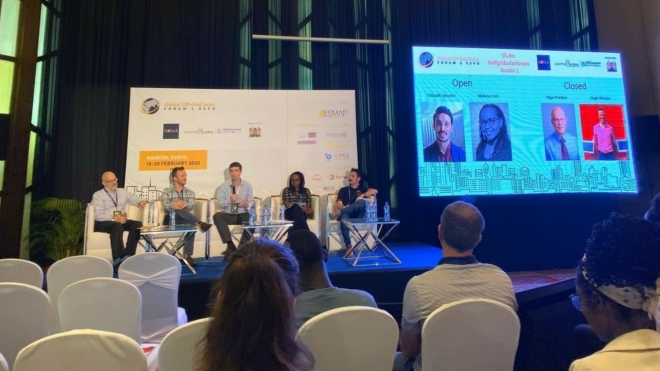
4. Leaving no one behind part 1 – will subsidies or consumer financing crack the affordability nut?
Every major piece of research over the past year cites affordability as the primary barrier to uptake of higher powered systems and life-changing productive use tech. Some say the best way to address affordability is through subsidies. Others are dubious and want to know who and what to direct them to precisely. Some say governments are more likely to support demand-side subsidies because they don’t create competition between SHS and main grid connection. Results-based financing can be an effective mechanism, but what are the other financial and market stimulation approaches? The conversations were as circuitous as this paragraph.
What we know to be true: Some households will be left behind without subsidies, even if scale and technical improvements continue to bring down costs.
5. Leaving no one behind part 2 – an enabling policy environment
While more than one panelist accused donors and investors of becoming transfixed by ‘shiny objects,’ i.e. new technologies (we won’t name names), many companies, aid agencies and others brought keen awareness of issues in the operating environment.
Solar lanterns, which continue serving ‘the bottom rung’ of the energy ladder, still compete with cheap knock-offs in every market. (Meanwhile, there are still hundreds of millions who can’t even afford pico-lighting.)
“The entry of low quality products is the biggest challenge we are grappling with,” said Dr Taylor, Deputy Minister of Energy, Sierra Leone at the future of the solar lantern market session.
The newly launched VeraSol, in partnership with the World Bank Group and Africa Clean Energy (ACE), are working together to help governments in Sub-Saharan Africa adopt and align quality standards for solar lighting products. Still, companies are calling for greater investment in market surveillance and policy enforcement.
“The role of the donor and investor community is to support policy and national enforcement for high quality off-grid solar products,” Charlotte Heffer of d.light
Meanwhile, USAID and the Global LEAP Awards gave awards for emerging practices in e-waste management, a growing concern for the sector as it celebrates its 10th
year of producing stuff. Kenya already has an e-waste management policy in place, and Rwanda, through evolving policies and practices, may soon be leading the pack. Implementation and enforcement of those policies remain essential for a low-junk sectoral footprint.
6. We don’t believe in silver bullets, but how about electric cooking?
MECS research indicates that electric cooking can be the most efficient cooking solution in 2025 if the cost of battery and mini-grid tariffs are reduced. MECS, ESMAP and CLASP convened a side session presenting research on electric cooking. Early pilots are taking place on mini-grids, with urban grid-connected customers, and in a select number of SHS. Consumer feedback from mains connected homes and mini-grid users has been overwhelmingly positive, with convenience cited as the greatest benefit. A lack of quality DC electric pressure cookers is holding back growth in the SHS market segment, but efforts like the Global LEAP Awards for Electric Pressure Cookers hope to spur innovation and accelerate the development of more appropriate designs.
A panel moderated by Dymphna van der Lans, CEO of the Clean Cooking Alliance, signaled to all that the clean cooking community and off-grid solar sector are coming together as one to tackle one of the world’s most pressing issues. We’re here for it!
Notably, during his tour of the conference expo, Kenyan President Uhuru Kenyatta was particularly interested in this technology and requested to take one back with him to the statehouse.

7. The climate-energy access nexus
We noticed a surge of chatter about connecting the dots between climate change mitigation and clean energy access. But is there a story to be told? If so, it goes something like this:
The carbon footprint of Africa and South Asia has the potential to spike in the coming decades as hundreds of millions of households and businesses gain access to energy. Distributed renewable energy paired with highly efficient appliances has the potential to create a low carbon pathway for development and displace carbon intensive alternatives like diesel generators and other fossil fuels.
In the near-term, off-setting diesel generation and electrifying cooking have the highest potential to reduce GHG emissions. But over the long term, we need to create a sustainable pathway to increase access to cooling, both from an emissions reduction and climate adaptation perspective.
Off-grid appliances can also contribute to climate resilience by helping farmers adjust to unpredictable rainfall and longer droughts and climate adaptation in a warming world. Speaking of warm, has your development program thought about super-efficient fans as a complementary, affordable, low-carbon emitting alternative to ACs?
8. Consumer-centered design
As products become increasingly expensive and complex, how consumers engage with them is top of mind for everyone designing and selling. Product and program design can have unintended consequences for how consumers use products, and therefore how satisfied they are with new purchases. A new 60 Decibels report benchmarking different sectors within energy access indicates a high percentage of customers report challenges using their appliances — 39%.
According to CLASP expert Elisa Lai, when Global LEAP Award-winning refrigerators were field tested in Uganda, 88% of products consumed more energy than in the lab, with potential repercussions for affordability.
The CLASP team was struck in the electric cooking session when audience member Agnes Kalyonge, the founder of Jikoni Magic, said that innovative product design can exacerbate existing gender inequities, i.e., as an appliance becomes more technical or expensive it can make it less likely that women will have control over its purchase and use. Anecdotal evidence indicates this is happening in other areas of the agricultural value chain, e.g. men supplanting women in milking and dairy chilling once the business model becomes profitable.
In context, consumer-centered approaches for appliances should center issues of energy performance & durability, design, affordability, and social impact. Watch this space!
9. A matter of quality
There’s no substitute for quality products to change people’s lives, and that is why we were thrilled to launch VeraSol, an evolved quality assurance program for the off-grid sector. Building upon the strong foundation of Lighting Global Quality Assurance, VeraSol will house data and information on performance and quality for a broad swath of products (it’s merging with Equip Data), as well as tackle policy and a range of enabling environment issues.
Check out this BBC interview with VeraSol partner Arne Jacobson of the Schatz Energy Research Center at Humboldt State University citing the potential of solar appliance technologies, enduring importance of quality, and new IEC standards for stand-alone energy kits. (Arne starts at 3:35.)
‘Many customers in off-grid markets are aware of the products available and understand the importance of quality. Messaging and marketing for last-mile channels will be important moving forward.’ — Anjali Garg, Lighting Asia/India
We’re excited to keep working in time with the sector to selectively expand quality assurance services, including developing an external brand that is more usable and flexible for companies. Stay tuned!
Compatibility and Interoperability Technology Roadmap
Commoditization is a key challenge to early stage market growth for a wide range of technologies. Custom solutions work well when companies have markets to themselves, but as markets grow, they become a barrier to market efficiency. While limiting consumer choice to custom products makes sense from a system provider’s perspective, incompatibility between systems locks consumers into a product regardless of its merits relative to the competition, discouraging market growth.
Compatibility and interoperability refer to the ability of systems and components to work together in the same environment, including the exchange of information. Both are key features of mature markets for a variety of technologies around the world. While most off-grid companies are not focused on these topics today, they will become increasingly important as the market matures.
This technology roadmap outlines an important first step in defining the requirements for a mature off-grid industry. It highlights the need for industry working groups and defines the focus and needs for future research and development.
Download the Compatibility and Interoperability Technology Roadmap
Efficiency for Access Interoperability & Compatibility Roadmap to Drive Off-Grid Solar Products Toward Maturity
Efficiency for Access recently published a technology roadmap focusing on interoperability and compatibility, both strong enabling technologies for the off-grid industry. Compatibility and interoperability, which refer to the ability of systems and components to work together in the same environment, including the exchange of information, are key features of mature markets for a variety of technologies around the world. While most off-grid companies are not focused on these topics today, they will become increasingly important as the market matures.
A key challenge to growth in any early stage market is commoditization. Custom solutions work well when companies have markets to themselves, but when markets grow, custom solutions become a barrier to market efficiency. Limiting consumer choice to custom products may make sense from a particular system provider’s perspective, but incompatibility between systems locks consumers into a product regardless of its merits relative to the competition, discouraging market growth.
This roadmap may act as a first step towards defining the requirements for a mature off-grid industry. The roadmap recommends that the off-grid industry should identify companies willing to lead and/or participate in working groups focused on:
- Defining uniform requirements for electrical connectivity
- Deciding on approaches to connectivity in support of load management in SHSs, which might be accomplished though industry consensus but might also lead to specifying R&D activities to improve the available options
- Informing and supporting the R&D activities specified below
The roadmap also makes recommendations for related research and development activities, including:
- Development of power distribution connectivity interfaces and protocols to support load management in solar home systems, depending on industry consensus around whether such R&D is necessary
- Development of power distribution connectivity interfaces and protocols to support the ability of SHS controllers to interface with other SHS systems, DC minigrids, or AC minigrids
- Development of general data connectivity and communications interfaces and protocols for remote monitoring of systems and appliances
- Development of interfaces and protocols for an interoperable PAYG solution for controllers and appliances
The roadmapping process often exposes the tension between cooperation and competitiveness. To have a larger impact on the market, off-grid companies must be willing to cooperate on a pre-competitive basis, working together to identify common customer needs and technology strategies. This roadmap outlines important junctures for sector collaboration and consensus that, if achieved, can push many nascent technologies toward maturity.
New Research from Efficiency for Access & Partners for the Off-Grid Solar Sector
Markets for off-grid appropriate appliances are nascent throughout much of the world. Manufacturers, development institutions, bulk procurers, policymakers and others often lack access to the data and market intelligence needed to design, source, and promote high-performing products that meet consumer needs. Efficiency for Access and our partners are excited to share a new suite of research to empower clean energy access stakeholders with consumer, technical, and market intelligence. These include a collaborative research effort with 60 Decibels on the benefits of solar water pump technologies; with GOGLA and the World Bank Group on the semi-annual Global Off-grid Solar Market Report, which has been expanded to appliances; Equip Data, a new, independent tool that shares key performance and quality data for over 250 off-grid appliances; a first-ever policy brief; and a technical roadmap for solar water pump technologies.
New Report Reveals Impacts of Solar Water Pumps on Quality of Life
Efficiency for Access partnered with 60 Decibels to survey 375 customers in Uganda, Kenya and Tanzania about their experiences with solar water pumps. This analysis provides valuable insights into purchasing decisions and use cases. Notably, it provides compelling preliminary evidence on the impacts pumps have on productivity and quality of life through the eyes of consumers.
Read “Use and Benefits of Solar Water Pumps.”
Global Off-Grid Solar Market Report Expands to Appliances
Efficiency for Access partnered with GOGLA and the World Bank Group’s Lighting Global program to publish the semi-annual Global Off-Grid Solar Market Report. Sales of off-grid solar appliances were reported at 350,000 in H2 2018, with TVs and fans as the most widely sold product types. The report’s expansion to off-grid appliances signals a new frontier for many companies and underscores the need to enhance sales data collection efforts.
Read the Global Off-Grid Solar Market Report.
Efficiency for Access Launches Equip Data, an Appliance Data Platform
CLASP is excited to announce the launch of Equip Data, a new independent, open-access resource that shares key performance and quality data for over 250 off-grid appliances. By providing manufacturers, distributors, policymakers and investors with reliable performance data and benchmarking tools, Equip Data brings the transparency and consistency needed to scale the market for durable, high-performing, and affordable appliances and equipment. Data is now available for over 140 televisions, 120 fans, and 50 refrigerators.
Efficiency for Access Develops First Ever Policy Brief on High-Performing, High-Efficiency Off-Grid Appliances
The Efficiency for Access Coalition released its first policy brief in June. High-quality, energy-efficient off-grid appliances are essential to ensuring consumer protection and overall health as markets mature. This exciting new resource explores how test methods, quality standards, and labeling might be used to promote energy efficiency and quality in off- and weak-grid appropriate appliances.
Solar Water Pump Technology Roadmap Charts New Path for Industry Partners
From May 2018 to May 2019, the Efficiency for Access Coalition convened a technical working group to construct an industry roadmap for solar water pumps, which identifies a series of technology improvements for remote monitoring systems and brushless DC motors that, if adopted, could improve pump efficiency and performance. It also outlines recommendations for future research, including: connectivity, the impact of water quality on durability, quality assurance, and specific in-country barriers. Together these components form a common starting point for further investment and industry collaboration.
Off- and Weak-Grid Appliance & Equipment Technology Summaries
Appropriately-designed, highly energy-efficient, cost-effective appliances are essential to delivering modern energy services to underserved communities around the world at the lowest possible social, economic and environmental cost. Because of this, they are an essential tool in scaling and accelerating global energy access and sustainable development efforts. Just as super-efficient LED technology has unlocked modern lighting for tens of millions of un- and under-electrified businesses and households, super-efficient appliances promise to unlock life-changing modern energy services—like telecommunications, cooling, mechanization and refrigeration—for millions more. But a great deal of technical progress and market development will be needed to realize this.
Low-Energy Inclusive Appliances (LEIA) is a new research and innovation programme supported by the UK AID that aims to double the efficiency and halve the cost of a suite of appliances that are well-suited for energy access contexts. LEIA will support a slate of research, innovation and market scaling frameworks that will enable entrepreneurs, policymakers, investors and other partners working in energy access to better utilize appliances to improve the lives for the world’s poorest people.
About This Document
In developing LEIA through late 2016 and early 2017, UK AID engaged CLASP—an international appliance energy efficiency policy and market transformation NGO—to research and advise upon the programme’s proposed scope.
Through an extensive literature review, data and market analysis, a market survey, and expert consultation process, CLASP and UK AID identified appliance products and technologies that LEIA may emphasize in its programmes and research:
- appliances for which the demand is strong and clear, but efficient products are only available in low volumes and at relatively high cost
- early stage technologies which may be disruptive to existing dominant appliances. These technologies may create opportunities to leapfrog in terms of efficiency or cost, with implications potentially for a whole range of products.
Among these, four near-to-market products are identified: refrigerators, televisions, fans, and solar water pumps. These products make up a substantial portion of near-term consumer demand in off- and weak-grid settings and technical improvements and market scale-up can be expected to support stronger market fundamentals and improved access in the short-run.
Download the Off- and Weak-Grid Appliance & Equipment Technology Summaries to learn more.

